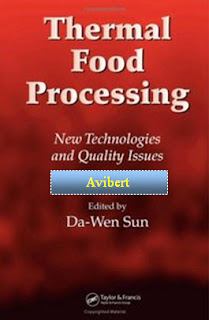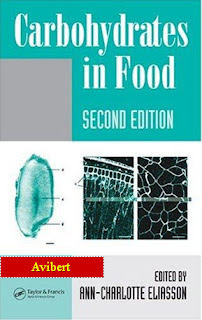Thermal Food Processing New Technologies and Quality Issues
Da-Wen Sun

A pedido de Sara. Ver capítulo 11 - tratamiento de alimentos enlatados.
Table of Contents
Part I:
Modeling of Thermal Food Processes
Chapter 1
Thermal Physical Properties of Foods
Chapter 2
Heat and Mass Transfer in Thermal Food Processing
Chapter 3
Simulating Thermal Food Processes Using Deterministic Models
Chapter 4
Modeling Food Thermal Processes Using Artificial Neural Networks
Chapter 5
Modeling Thermal Processing Using Computational Fluid Dynamics (CFD)
Part II:
Quality and Safety of Thermally Processed Foods
Chapter 6
Thermal Processing of Meat Products
Chapter 7
Thermal Processing of Poultry Products
Chapter 8
Thermal Processing of Fishery Products
Chapter 9
Thermal Processing of Dairy Products
Chapter 10
UHT Thermal Processing of Milk
Chapter 11
Thermal Processing of Canned Foods
Chapter 12
Thermal Processing of Ready Meals
Chapter 13
Thermal Processing of Vegetables
Part III:
Innovations in Thermal Food Processes
Chapter 14
Ohmic Heating for Food Processing
Chapter 15
Radio Frequency Dielectric Heating
Chapter 16
Infrared Heating
Chapter 17
Pressure-Assisted Thermal Processing
Chapter 18
pH-Assisted Thermal Processing
Chapter 19
Time–Temperature Integrators for Thermal Process Evaluation
Petroleum Refining Technology and Economics - Fourth Edition

A pedido de Ingeniero
Contents
Chapter 1
Introduction
Chapter 2
Refinery Products
Chapter 3
Refinery Feedstocks
Chapter 4
Crude Distillation
Chapter 5
Coking and Thermal Processes
Chapter 6
Catalytic Cracking
Chapter 7
Catalytic Hydrocracking
Chapter 8
Hydroprocessing and Resid Processing
Chapter 9
Hydrotreating
Chapter 10
Catalytic Reforming and Isomerization
Chapter 11
Alkylation and Polymerization
Chapter 12
Product Blending
Chapter 13
Supporting Processes
Chapter 14
Lubricating Oil Blending Stocks
Chapter 15
Petrochemical Feedstocks
Chapter 16
Additives Production from Refinery Feedstocks
Chapter 17
Cost Estimation
Chapter 18
Economic Evaluation
The Science of Chocolate - 2nd Edition Stephen T. Beckert

A pedido de Hess
Table of Contents
Chapter 1
The History of Chocolate
Chapter 2
Chocolate Ingredients
Chapter 3
Cocoa Bean Processing
Chapter 4
Liquid Chocolate Making
Chapter 5
Controlling the Flow Properties of Liquid Chocolate
Chapter 6
Crystallising the Fat in Chocolate
Chapter 7
Manufacturing Chocolate Products
Chapter 8
Analytical Techniques
Chapter 9
Different Chocolate Products
Chapter 10
Legislation, Shelf Life and Packaging
Chapter 11
Nutrition and Health
Chapter 12
Experiments with Chocolate and Chocolate Products
Fundamentals of Heat Exchanger Design Ramesh K. Shah and Dusan P. Sekulic
 <
Contents
<
Contents
Chapter 1
Classification of Heat Exchangers
Chapter 2
Overview of Heat Exchanger Design Methodology
Chapter 3
Basic Thermal Design Theory for Recuperators
Chapter 4
Additional Considerations for Thermal Design of Recuperators
Chapter 5
Thermal Design Theory for Regenerators
Chapter 6
Heat Exchanger Pressure Drop Analysis
Chapter 7
Surface Basic Heat Transfer and Flow Friction Characteristics
Chapter 8
Heat Exchanger Surface Geometrical Characteristics
Chapter 9
Heat Exchanger Design Procedures
Chapter 10
Selection of Heat Exchangers and Their Components
Chapter 11
Thermodynamic Modeling and Analysis
Chapter 12
Flow Maldistribution and Header Design
Chapter 13
Fouling and Corrosion
Appendix A: Thermophysical Properties
Appendix B: "-NTU Relationships for Liquid-Coupled Exchangers
Appendix C: Two-Phase Heat Transfer and Pressure Drop Correlations
C.1 Two-Phase Pressure Drop Correlations
C.2 Heat Transfer Correlations for Condensation
C.3 Heat Transfer Correlations for Boiling
Appendix D: U and CUA Values for Various Heat Exchangers
General References on or Related to Heat Exchangers
Industrial Biotransformations - 2Ed Edited by A. Liese, K. Seelbach, C. Wandrey

Contents
Chapter 1
Introduction
Chapter 2
History of Industrial Biotransformations - Dreams and Realities
2.1 From the ªflower of vinegarº to the recombinant E. coli - The history of microbial biotransformations
2.2 From gastric juice to SweetzymeT - The history of enzymatic biotransformations
2.3 Advantages of biotransformations over classical chemistry
Chapter 3
Enzyme Classification
3.1 The Enzyme Nomenclature
3.2 The Enzyme Classes
EC 1 Oxidoreductases
EC 2 Transferases
EC 3 Hydrolases
EC 4 Lyases
EC 5 Isomerases
EC 6 Ligases
Chapter 4
Basics of Bioreaction Engineering
4.1 Definitions
4.2 Biosynthesis and immobilization of biocatalysts
4.3 Characteristics of the different enzyme classes
4.4 Kinetics
4.5 Basic reactor types and their mode of operation
Chapter 5
Processes
Index
Index of enzyme name
Index of strain
Index of company
Index of starting material
Index of product
Structured and Modified Lipids Food Technology

Contents
Chapter 1
Why Are Structured Lipids and New Lipid Sources Required?
Chapter 2
Procedures Used for Lipid Modification
Chapter 3
Methods of Protection of Products of Increasing Quality and Value
Chapter 4
Specialty Vegetable Oils Containing γ-Linolenic Acid and Stearidonic Acid
Chapter 5
Palm Oil
Chapter 6
Vegetable Oils with Fatty Acid Composition Changed by Plant Breeding or by Genetic Modification
Chapter 7
Minor Oils, Specialty Oils, and Superrefined Oils
Chapter 8
Structured Triacylglycerols
Chapter 9
Phospholipids
Chapter 10
Sources, Functions, and Analysis of Conjugated Linoleic Acid and its Metabolites
Chapter 11
Improvement of the Nutritional and Physicochemical Properties of Milk Fat
Chapter 12
Fish Oils as Sources of Important Polyunsaturated Fatty Acids
Chapter 13
Microorganisms as Sources of Polyunsaturated Fatty Acids
Chapter 14
Cocoa Butter and Cocoa Butter Equivalents
Chapter 15
Spreads
Chapter 16
Infant Formulas
Chapter 17
Achieving Optimal Fatty Acid Intake Through Manufactured Foods
Chapter 18
Reduced-Energy Lipids
Chapter 19
Zero Energy Fat-Like Substances: Olestra
Recent Advances in Polyphenol Research Fouad Daayí - Vicenzo Lattanzio

Table of Contents
Chapter 1
Plant Phenolics – Secondary Metabolites with Diverse Functions
Chapter 2
Lignification: are Lignins Biosynthesized via simple Combinatorial Chemistry or via Proteinaceous Control and Template Replication?
Chapter 3
Flavonoid–Protein Binding Processes and their Potential Impact on Human Health
Chapter 4
Methods for Synthesizing the Cocoa-Derived Oligomeric Epi-Catechins – Observations on the Anticancer Activity of the Cocoa Polyphenols
Chapter 5
Gene Discovery and Metabolic Engineering in the Phenylpropanoid Pathway
Chapter 6
Recent Advances in the Molecular Biology and Metabolic Engineering of Flavonoid Biosynthesis in Ornamental Plants
Chapter 7
Recent Advances in the Field of Anthocyanins – Main Focus on Structures
Chapter 8
Salicylic Acid and Induced Plant Defenses
Chapter 9
Phenols and the Onset and Expression of Plant Disease Resistance
Chapter 10
Bioactivity, Absorption, and Metabolism of Anthocyanins
Chapter 11
Bioavailability, Metabolism, and Bioactivity of Food Ellagic Acid and Related Polyphenols
Chapter 12
Multiplicity of Phenolic Oxidation Products in Apple Juices and Ciders, from Synthetic Medium to Commercial Products
Chapter 13
Phytoestrogens in Drug Discovery for Controlling Steroid Biosynthesis
Chapter 14
Recent Advances in the Chemical Synthesis and Biological Activity of Phenolic Metabolites
Chapter 15
Polyphenols and Gene Expression
Carbohydrates in Food - Second Edition by Ann - Charlotte Eliasson

Table of Contents
Chapter 1
Mono- and Disaccharides: Analytical Aspects
Chapter 2
Mono- and Disaccharides: Selected Physicochemical and Functional Aspects
Chapter 3
Health Aspects of Mono- and Disaccharides
Chapter 4
Cell-Wall Polysaccharides: Structural, Chemical, and Analytical Aspects
Chapter 5
Functional Aspects of Cereal Cell-Wall Polysaccharides
Chapter 6
Gums and Hydrocolloids: Analytical Aspects
Chapter 7
Gums and Hydrocolloids: Functional Aspects
Chapter 8
Nondigestible Carbohydrates: Nutritional Aspects
Chapter 9
Starch: Analytical Aspects
Chapter 10
Starch: Physicochemical and Functional Aspects
Chapter 11
Starch: Nutritional Aspects
Advances in Food Diagnostics Food Technology

Contents
Chapter 1
Assuring Safety and Quality along the Food Chain
Chapter 2
Methodologies for Improved Quality Control Assessment of Food Products
Chapter 3
Application of Microwaves for On-line Quality Assessment
Chapter 4
Ultrasounds for Quality Assurance
Chapter 5
NMR for Food Quality and Traceability
Chapter 6
Electronic Nose for Quality and Safety Control
Chapter 7
Rapid Microbiological Methods in Food Diagnostics
Chapter 8
Molecular Technologies for Detecting and Characterizing Pathogens
Chapter 9
DNA-Based Detection of GM Ingredients
Chapter 10
Protein-Based Detection of GM Ingredients
Chapter 11
Immunodiagnostic Technology and Its Applications
Chapter 12
Rapid Liquid Chromatographic Techniques for Detection of Key (Bio)Chemical Markers
Chapter 13
Sampling Procedures with Special Focus on Automatization
Chapter 14
Data Processing
Chapter 15
Data Handling
Chapter 16
The Market for Diagnostic Devices in the Food Industry
Estadística para Química Analítica Miller - Miller

Índice general
Capítulo 1
Introducción
Capítulo 2
Errores en el análisis clásico. Estadística de medidas repetidas
Capítulo 3
Pruebas de significación
Capítulo 4
Control de calidad y muestreo
Capítulo 5
Errores en análisis instrumental; regresión y correlación
Capítulo 6
Métodos no paramétricos y de ejecución rápida
Capítulo 7
Diseño experimental, optimización y reconocimiento de pautas
Fermentaciones Lácticas Tecnología de los Alimentos
 La producción de sabor, aroma y textura en productos lácteos se origina en las fermentaciones de la glucosa derivada de la hidrólisis de lactosa y la fermentación del ácido cítrico que está en una proporción del 0,2% en la leche.
La producción de sabor, aroma y textura en productos lácteos se origina en las fermentaciones de la glucosa derivada de la hidrólisis de lactosa y la fermentación del ácido cítrico que está en una proporción del 0,2% en la leche.El conocimiento de los distintos procesos fermentativos constituye una herramienta fundamental en el manejo tecnológico de los alimentos.
Producción de ácido láctico
Es producido por todas las bacterias lácticas y es la fermentación más importante en la leche, realizándose en una rango de temperaturas de 10 a 50 ºC, provocando la coagulación ácida al llegar a un pH de 4,6. A este pH se presenta el punto isoeléctrico de la caseína. Ver reacción
Producción de ácido propiónico
Esta fermentación la efectúan bacterias heterofermentativas utilizadas en quesería (Elemental, suizo, Gruyere, etc.) donde el ácido láctico es transformado en ácido propiónico y acético con desprendimiento de CO2, el cuál forma los ojos en los quesos (Propionibacterium shermanii). Clic para ver reacción
Fermentación de ácido cítrico
Esta fermentación la efectúan bacterias heterofermentativas, utilizadas en cremas, mantequillas y quesos, ya que transforman el ácido cítrico en productos aromatizantes como la acetoína y el diacetilo (Leuconostoc citrovorum, Strephtococcus diacetilactis, etc.). Clic para ver reacción
Fermentación alcohólica
Algunas levaduras de los géneros Torula y Cándida se desarrollan simbióticamente con las bacterias lácticas y metabolizan la glucosa produciendo etanol y CO2.
Por otro lado las bacterias Kluyveromyces lactis y Kluyveromyces fragilis se utilizan junto con las bacterias lácticas para la producción de kefir y koumis, dos productos de leches acidificadas que contienen etanol. Ver reacción
Otras fermentaciones
Otros tipos de fermentaciones que se consideran nocivas son las que producen ácido butírico, ya que además del olor desagradable que produce y el cual genera gran cantidad de CO2 en quesería, hace que los productos se inflen y se fracturen (Clostridium sporogenes).
Las fermentaciones por coliformes y por bacteriófagos también son comunes en la industria láctea.
Chemical Engineering Dynamicsby J. Ingham, J. Dunn, E. Heinzle, E. Prënosil, B. Snape

Contents
1 Basic Concepts
1.1 Modelling Fundamentals
1.2 Formulation of Dynamic Models
1.3 Chemical Kinetics
1.4 Mass Transfer Theory
2 Process Dynamics Fundamentals
2.1 Signal and Process Dynamics
2.2 Time Constants
2.3 Fundamentals of Automatic Control
2.4 Numerical Aspects of Dynamic Behaviour
3 Modelling of Stagewise Processes
3.1 Introduction
3.2 Stirred-Tank Reactors
3.3 Stagewise Mass Transfer
4 Differential Flow and Reaction Applications
4.1 Introductio
4.2 Diffusion and Heat Conduction
4.3 Tubular Chemical Reactors
4.4 Differential Mass Transfer
4.5 Heat Transfer Applications
4.6 Difference Formulae for Partial Differential Equations
5 Simulation Tools and Examples of Chemical Engineering Processes
5.1 Simulation Tools
5.2 Batch Reactor Examples
5.3 Continuous Tank Reactor Examples
5.4 Tubular Reactor Examples
5.5 Semi-Continuous Reactor Examples
5.6 Mixing-Model Examples
5.7 Tank Flow Examples
5.8 Process Control Examples
5.9 Mass Transfer Process Examples
5.10 Distillation Process Examples
5.11 Heat Transfer Examples
5.12 Diffusion Process Examples
5.13 Biological Reaction Examples
5.14 Environmental Examples
Bisfenol A en Plásticos de Uso Alimentario
 El uso de esta sustancia en la elaboración de plásticos como envases alimentarios y sus posibles implicaciones en la salud humana reabre la polémica en EE.UU.
El uso de esta sustancia en la elaboración de plásticos como envases alimentarios y sus posibles implicaciones en la salud humana reabre la polémica en EE.UU.El bisfenol A (BPA) es un producto químico que se utiliza para la elaboración de material plástico que puede ir destinado, entre otras funciones, a entrar en contacto con alimentos. Algunas botellas de plástico, biberones, elementos de vajilla como tazas y platos están compuestos por este policarbonato, un plástico rígido transparente que trae de cabeza a los responsables sanitarios de Canadá y Estados Unidos. El primer país ya ha prohibido el uso de esta sustancia para la elaboración de biberones, y el segundo acaba de dar por finalizado el estudio que concluye que no hay evidencias científicas sobre sus efectos perjudiciales, una postura similar a la que mantiene la Autoridad Europea de Seguridad Alimentaria (EFSA, en sus siglas inglesas).
La ingesta diaria tolerable (IDT) para las personas de bisfenol A es de 0,05 miligramos por kilo de peso corporal al día, según establecía en 2007 la EFSA, que es la cantidad que un consumidor (incluyendo bebés y niños) puede ingerir con seguridad sin efectos dañinos. Considerada como segura, no es probable que esta cantidad se modifique, al menos por ahora, a tenor de la respuesta que ha tenido, junto con la Agencia de Seguridad Alimentaria británica (FSA), una de las principales autoridades en materia de seguridad alimentaria en la Unión Europea, la EFSA.
Todo ello pese a la preocupación que ha suscitado el uso de esta sustancia en EE.UU. y Canadá como componente en envases destinados a estar en contacto con alimentos. La polémica surgió con la publicación en septiembre de 2008 de un estudio en la revista "JAMA" que advertía que la exposición a esta sustancia superaba los límites establecidos como seguros y que esta exposición podría tener efectos en la salud de las personas, como alteraciones hepáticas o daño neurológico.
Opiniones encontradas
Los fabricantes de biberones de Canadá han dejado de utilizar esta sustancia basándose en los estudios que advierten de que el bisfenol A podría alterar el equilibrio hormonal del cuerpo y que la exposición de la población general superaba los límites establecidos como seguros. También en 2008, el Programa Nacional de Toxicología estadounidense, que forma parte de los institutos nacionales de salud del país, mostraba su preocupación por los posibles efectos perjudiciales de esta sustancia en bebés y niños pequeños.
Distintos organismos europeos afirman que la exposición humana actual a bisfenol A no constituye un riesgoEstos resultados han encontrado hace unos días un nuevo aliado en un estudio realizado por expertos de la Escuela de Salud Pública de Harvard, según el cual el policarbonato utilizado para fabricar botellas se asocia a enfermedad cardiovascular y diabetes en humanos. Lo que concluye la investigación es que las personas que durante una semana bebieron de este tipo de botellas (un total de 77) aumentaron en un 69% la cantidad de BPA en su orina.
Tras estos estudios, la EFSA, que ya había realizado varios análisis sobre estos efectos, determinó que algunos de estos resultados no "son concluyentes" en la relación causa-efecto, ya que no se tienen en cuenta otras valoraciones científicas hechas al respecto. De ahí su decisión de no efectuar una nueva revisión de los límites de ingesta diaria y atendiendo al hecho de que considera que se trata de una sustancia que el cuerpo "metaboliza y elimina de forma rápida".
También otras instituciones y autoridades se han puesto manos a la obra y han iniciado diversas revisiones sobre los riesgos reales de la exposición al BPA en contacto con alimentos. A la EFSA le han seguido el Instituto Federal para el Análisis de Riesgo alemán, la Agencia de Protección Ambiental danesa, la Autoridad de Seguridad Alimentaria francesa y la Oficina para la Salud Pública suiza, además de la Agencia de Medicamentos y Alimentos estadounidense. Todas ellas concluyen que los niveles establecidos ahora "son seguros" y, por tanto, la exposición de las personas a través de los alimentos no constituye ningún peligro porque la cantidad de sustancia que migra del envase al alimento es mínima.
Evitar migraciones
Uno de los problemas que plantea el uso de BPA en la elaboración de materiales en contacto con alimentos, al igual que cualquier otro material que contenga sustancias químicas y sea utilizado para este fin, es la migración de sustancias del envase al alimento. Según la EFSA, sin embargo, estos niveles de migración son menores a los 10 microgramos por kilo de alimentos, una cifra muy inferior a lo que establece la normativa y que sitúa este límite en los 600 microgramos por kilo de alimento. En junio de 2008 el organismo volvía a actualizar los datos sobre la seguridad de los biberones elaborados con policarbonato y otras botellas y otros envases como latas y bebidas revestidas con resinas epoxi, otro de los elementos utilizados en la elaboración de plásticos.
El bisfenol A, una sustancia química orgánica, es fundamental para producir policarbonato, un plástico con unas particularidades (alta resistencia al calor, duradero y gran transparencia) que lo hacen idóneo para la elaboración de infinidad de objetos, como DVD, electrodomésticos, gafas de sol, material médico (respiradores o equipos de diálisis), biberones y botellas reutilizables, y techos en los coches o cascos deportivos.
ENVASES INTELIGENTES BAJO NORMA
La tecnología alimentaria de los últimos años se ha centrado de forma especial en el desarrollo de nuevos envases, los denominados activos e inteligentes, cuyas particularidades responden a una mayor prolongación de la vida útil de los alimentos y a un mejor mantenimiento de su estado. Uno de los objetivos es incorporar, de forma intencionada, componentes que liberan sustancias en el alimento o en su entorno. Ahora, el uso de estos materiales cuenta con una nueva regulación europea, aprobada el pasado mes de mayo, por la que se establecen los requisitos específicos que permiten su comercialización.
Uno de estos requisitos es la creación de una lista comunitaria de sustancias que pueden utilizarse para la elaboración de este tipo de materiales. La norma establece que antes de introducirlas en un envase, estas sustancias deben ser analizadas y autorizadas por la Autoridad Europea de Seguridad Alimentaria (EFSA). En este sentido, debe tenerse en cuenta que hay numerosos tipos de materiales activos e inteligentes, y que las sustancias responsables de esta función pueden estar incorporadas directamente en el material (plástico, papel o cartón) o ir en un recipiente aparte. El hecho de que este tipo de sustancias se incorporen en el alimento obliga a establecer condiciones para que este uso sea seguro, unas condiciones similares a las que se aplican en el caso de aditivos y enzimas alimentarias.
Autor: MARTA CHAVARRÍAS
Fuente: Consumer Eroski
A Small Dose of Toxicology Steven G. Gilbert

Contents
PART 1
Toxic agents
3 Alcohol
4 Caffeine
5 Nicotine
6 Pesticides
7 Lead
8 Mercury
9 Arsenic
10 Metals
11 Solvents
12 Radiation
13 Animal and plant toxins
14 Persistent environmental contaminants
PART 2
Targets of toxic agents
15 Neurotoxicology
16 Cancer and genetic toxicology
17 Pregnancy and developmental toxicology
PART 3
Applied toxicology
18 Toxics in the home
19 Risk assessment and risk management
Genes VIII - Repost by Benjamin Lewin

Tables of Contents
Part 1 Genes
1 Genes are DNA
2 The interrupted gene
3 The content of the genome
4 Clusters and repeats
Part 2 Proteins
5 Messenger RNA
6 Protein synthesis
7 Using the genetic code
8 Protein localization
Part 3 Gene expression
9 Transcription
10 The operon
11 Regulatory circuits
12 Phage strategies
Part 4 DNA
13 The replicon
14 DNA replication
15 Recombination and repair
16 Transposons
17 Retroviruses and retroposons
18 Rearrangement of DNA
Part 5 The Nucleus
19 Chromosomes
20 Nucfeosomes
21 Promoters and enhancers
22 Activating transcription
23 Controlling chromatin structure
24 RNA splicing and processing
25 Catalytic RNA
26 Immune diversity
Part 6 Cells
27 Protein trafficking
28 Signal transduction
29 Cell cycle and growth regulation
30 Oncogenes and cancer
31 Gradients, cascades, and signaling pathways
Piping and Pipelines Assessment Guide
A. Keith Escoe

Table of Contents
Chapter 1
An Introduction to In-plant Piping and Pipeline Fitness for Service
Chapter 2
An Introduction to Engineering Mechanics of Piping
Chapter 3
Fitness-for-Service Topics of Local Thin Areas, Plain Dents, Dents-Gouges, and Cracks for Piping
Chapter 4
Fitness-for-Service for Brittle Fracture Concerns
Chapter 5
Piping Support Systems for Process Plants
Chapter 6
Piping Maintenance and Repairs
Chapter 7
Hot Tapping (Pressure Tapping) and Freezing
Chapter 8
Pipeline Fitness for Service, Repair, and Maintenance - Selected Topics
Appendix A
Properties of Pipe
Appendix B
Weights of Pipe Materials
Appendix C
Formulas for Pipe, Internal Fluid, and Insulation Weights
Gente extraordinaria Daniel Tammet, una mente privilegiada
Fuente: Avidman78
Milk Processing
and Quality Management

Contents
Chapter 1
On-Farm Hygienic Milk Production
Chapter 2
Properties and Constituents of Cow’s Milk
Chapter 3
Microbiology of Raw and Market Milks
Chapter 4
Quality Control
Chapter 5
Current Legislation of Market Milks
Chapter 6
The Safety of Raw Liquid Milk
Chapter 7
Heat Treatment of Milk
Chapter 8
Novel Methods of Milk Processing
Chapter 9
Hygiene Practices in Liquid Milk Dairies
Chapter 10
Hazard Analysis (Appraisal) Critical Control Point (HACCP) in Milk Processing – A Practical Overview
Chapter 11
Sensory Profiling of Market Milks
Principles of Food Sanitation Norman G. Marriott - Robert B. Gravani

Contents
Chapter 1
Sanitation and the Food Industry
Chapter 2
The Relationship of Biosecurity to Sanitation
Chapter 3
The Relationship of Microorganisms to Sanitation
Chapter 4
The Relationship of Allergens to Sanitation
Chapter 5
Food Contamination Sources
Chapter 6
Personal Hygiene and Sanitary Food Handling
Chapter 7
The Role of HACCP in Sanitation
Chapter 8
Quality Assurance for Sanitation
Chapter 9
Cleaning Compounds
Chapter 10
Sanitizers
Chapter 11
Sanitation Equipment
Chapter 12
Waste Product Handling
Chapter 13
Pest Control
Chapter 14
Sanitary Design and Construction for Food Processing
Chapter 15
Low-Moisture Food Manufacturing and Storage Sanitation
Chapter 16
Dairy Processing Plant Sanitation
Chapter 17
Meat and Poultry Plant Sanitation
Chapter 18
Seafood Plant Sanitation
Chapter 19
Fruit and Vegetable Processing Plant Sanitation
Chapter 20
Beverage Plant Sanitation
Chapter 21
Foodservice Sanitation
Chapter 22
Management and Sanitation
Gene Cloning & DNA Analysis An Introduction - T. A. Brown - Repost

Contents
Part 1
The Basic Principles of Gene Cloning and DNA Analysis
Part 2
The Applications of Gene Cloning and DNA Analysis in Research
Part 3
The Applications of Gene Cloning and DNA Analysis in Biotechnology
























































